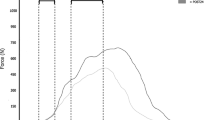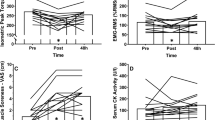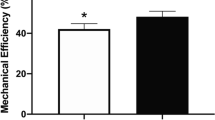Abstract
Delayed onset of muscle soreness (DOMS) is a common response to exercise involving significant eccentric loading. Symptoms of DOMS vary widely and may include reduced force generating capacity, significant alterations in biochemical indices of muscle and connective tissue health, alteration of neuromuscular function, and changes in mechanical performance. The purpose of the investigation was to examine the effects of downhill running and ensuing DOMS on running economy and stride mechanics. Nine, well-trained distance runners and triathletes participated in the study. Running economy was measured at three relative intensities [65, 75, and 85% of maximal aerobic capacity (V̇O2peak)] before (RE1) and 48 h after (RE2) a 30-min downhill run (−10%) at 70% V̇O2peak. Dependent variables included leg muscle soreness, rate of oxygen consumption (V̇O2), minute ventilation, respiratory exchange ratio, lactate, heart rate, and stride length. These measurements were entered into a two-factor multivariate analysis of variance (MANOVA). The analysis revealed a significant time effect for all variables and a significant interaction (time × intensity) for lactate. The energy cost of locomotion was elevated at RE2 by an average of 3.2%. This was coupled with a significant reduction in stride length. The change in V̇O2 was inversely correlated with the change in stride length (r= −0.535). Lactate was significantly elevated at RE2 for each run intensity, with a mean increase of 0.61 mmol l−1. Based on these findings, it is suggested that muscle damage led to changes in stride mechanics and a greater reliance on anaerobic methods of energy production, contributing to the change in running economy during DOMS.




Similar content being viewed by others
References
Asp S, Daugaard JR, Richter EA (1995) Eccentric exercise decreases glucose transporter GLUT4 protein in human skeletal muscle. J Physiol (Lond) 482:705–712
Asp S, Daugaard JR, Kristiansen S, Kiens B, Richter EA (1998) Exercise metabolism in human skeletal muscle exposed to prior eccentric exercise. J Physiol (Lond) 509:305–313
Borg G (1970) Perceived exertion as an indicator of somatic stress. Scand J Rehabil Med 2:92–98
Cavanagh PR, Williams KR (1982) The effect of stride length variation on oxygen uptake during distance running. Med Sci Sports Exerc 14:30–35
Clarkson PM, Sayers SP (1999) Etiology of exercise-induced muscle damage. Can J Appl. Physiol 24:234–248
Clarkson PM, Nosaka K, Braun B (1992) Muscle function after exercise-induced muscle damage and rapid adaptation. Med Sci Sports Exerc 24:512–520
Eston RG, Finney S, Baker S, Baltzopoulos V (1996) Muscle tenderness and peak torque changes after downhill running following a prior bout of isokinetic eccentric exercise. J Sports Sci 14:291–299
Gleeson M, Almey J, Brooks S, Cave R, Lewis A, Griffiths H (1995) Haematological and acute-phase responses associated with delayed-onset muscle soreness in humans. Eur J Appl Physiol 71:137–142
Gleeson M, Blannin AK, Walsh NP, Field CNE, Pritchard JC (1998) Effect of exercise-induced muscle damage on the blood lactate response to incremental exercise in humans. Eur J Appl Physiol 77:292–295
Hamill J, Freedson PS, Clarkson PM, Braun B (1991) Muscle soreness during running: biomechanical and physiological considerations. Int J Sport Biomech 7:125–137
Harrison BC, Robinson D, Davison BJ, Foley B, Seda E, Byrnes WC (2001) Treatment of exercise-induced muscle injury via hyperbaric oxygen therapy. Med Sci Sports Exerc 33:36–42
Jackson AS, Pollock ML (1978) Generalized equations for predicting body density of men. Br J Nutr 40:497–504
Johansson PH, Lindstrom L, Sundelin G, Lindstrom B (1999) The effects of preexercise stretching on muscular soreness, tenderness and force loss following heavy eccentric exercise. Scand J Med Sci Sports 9:219–225
Koskinen SOA, Hoyhtya M, Turpeenniemi-Hujanen T, Martikkala V, Makinen TT, Oksa J, Rintamaki H, Lofberg M, Somer H, Takala TES (2001) Serum concentrations of collagen degrading enzymes and their inhibitors after downhill running. Scand J Med Sci Sports 11:9–15
Kyrolainen H, Pullinen T, Candau R, Avela J, Huttunen P, Komi PV (2000) Effects of marathon running on running economy and kinematics. Eur J Appl Physiol 82:297–304
Lambert MI, Marcus P, Burgess T, Noakes TD (2002) Electro-membrane microcurrent therapy reduces signs and symptoms of muscle damage. Med Sci Sports Exerc 34:602–607
Lecomte JM, Lacroix VJ, Montgomery DL (1998) A randomized controlled trial of the effect of naproxen on delayed onset muscle soreness and muscle strength. Clin J Sport Med 8:82–87
Lee H, Goldfarb AH, Rescino MH, Hedge S, Patrick S, Apperson K (2002) Eccentric exercise effect on blood oxidative-stress markers and delayed onset of muscle soreness. Med Sci Sports Exerc 34:443–448
Lund H, Vestergaard-Poulsen P, Kanstrup I-L, Sejrsen P (1998) The effect of passive stretching on delayed onset muscle soreness, and other detrimental effect following eccentric exercise. Scand J Med Sci Sports 8:216–221
MacIntyre DL, Reid WD, McKenzie DC (1995) Delayed muscle soreness. The inflammatory response to muscle injury and its clinical implications. Sports Med 20:24–40
MacIntyre DL, Reid WD, Lyster DM, Szasz IJ, McKenzie DC (1996) Presence of WBC, decreased strength, and delayed soreness in muscle after eccentric exercise. J Appl Physiol 80:1006–1013
MacIntyre DL, Sorichter S, Mair J, Berg A, McKenzie DC (2001) Markers of inflammation and myofibrillar proteins following eccentric exercise in humans. Eur J Appl Physiol 84:180–186
Nosaka K, Newton M (2002a) Concentric or eccentric training effect on eccentric exercise-induced muscle damage. Med Sci Sports Exerc 34:63–69
Nosaka K, Newton M (2002b) Repeated eccentric exercise bouts do not exacerbate muscle damage and repair. J Strength Cond Res 16:117–122
Rawson ES, Gunn B, Clarkson PM (2001) The effects of creatine supplementation on exercise-induced muscle damage. J Strength Cond Res 15:178–184
Rodenburg JB, Bar PR, De Boer RW (1993) Relations between muscle soreness and biochemical and functional outcomes of eccentric exercise. J Appl Physiol 74:2976–2983
Sayers SP, Clarkson PM, Lee J. (2000) Activity and immobilization after eccentric exercise. II. Serum CK. Med Sci Sports Exerc 32:1593–1597
Sorichter S, Koller A, Haid C, Wicke K, Judmaier W, Werner P, Raas E (1995) Light concentric exercise and heavy eccentric muscle loading: effects on CK, MRI and markers of inflammation. Int J Sports Med 16:288–292
Sorichter S, Mair J, Koller A, Calzolari C, Huonker M, Pau B, Puschendorf B (2001) Release of muscle proteins after downhill running in male and female subjects. Scand J Med Sci Sports 11:28–32
Talag ST (1983) Residual muscular soreness as influenced by concentric, eccentric, and static contractions. Res Q Exerc Sport 44:458–469
Warren GL, Ingalls CP, Lowe DA, Armstrong RB (2001) Excitation–contraction uncoupling: major role in contraction-induced muscle injury. Exerc Sports Sci Rev 29:82–87
Weber MD, Servedio FJ, Woodall RW (1994) The effects of three modalities on delayed onset of muscle soreness. J Orthop Sports Phys Ther 20:236–242
Acknowledgement
The authors would like to thank Tom W. Spalding PhD, for his assistance with statistical analyses.
Author information
Authors and Affiliations
Corresponding author
Rights and permissions
About this article
Cite this article
Braun, W.A., Dutto, D.J. The effects of a single bout of downhill running and ensuing delayed onset of muscle soreness on running economy performed 48 h later. Eur J Appl Physiol 90, 29–34 (2003). https://doi.org/10.1007/s00421-003-0857-8
Accepted:
Published:
Issue Date:
DOI: https://doi.org/10.1007/s00421-003-0857-8




